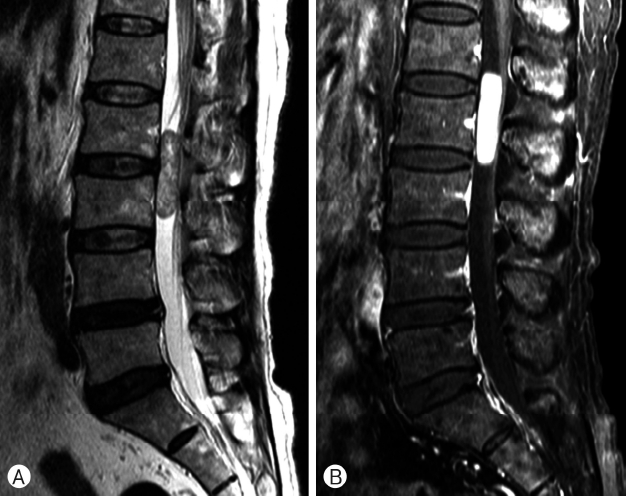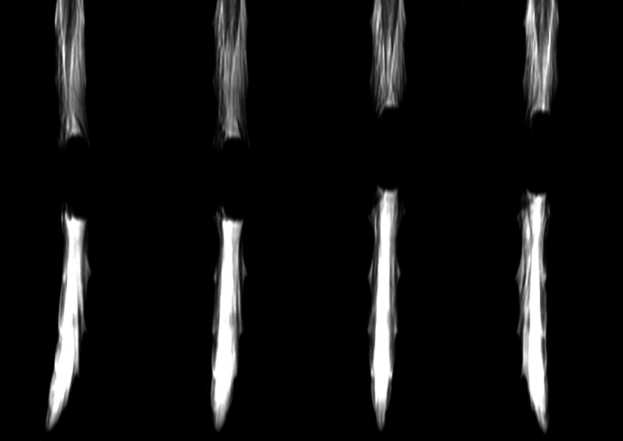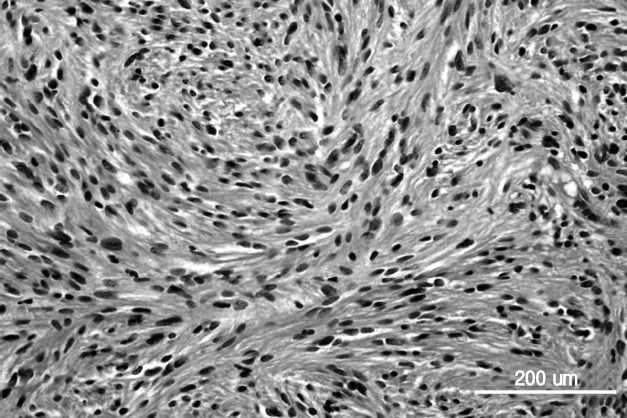INTRODUCTION
Mobile intradural extramedullary (IDEM) schwannoma is a rare disease entity1-7,9-17). Only 24 cases of mobile schwannoma have been reported in the literatures5-7,14,16). The mobility of schwannoma might result in failure to locate the tumor during surgery6,16). The mobility of schwannoma has been suggested to be associated with changes in intra-thecal pressure or spinal posture1,2,6,9-12,17). However, its mechanism is still not clearly understood.
We report a case of mobile schwannoma of the cauda equina diagnosed by magnetic resonance (MR) imaging (MRI) and MR myelography. MRI and gadolinium-enhanced MRI performed 2 hr later demonstrated a mobile IDEM tumor. MR myelography performed one week thereafter showed that the tumor moved suddenly in cranial direction during examination. This suggests that changes in intrathecal pressure is closely related to the mobility of the tumor. We also reviewed literatures about mobile schwannoma.
CASE REPORT
A 65-year-old man presented at our hospital suffering from pain in his lower back as well as paresthesia in both legs for 3 months prior. Physical examinations revealed absence of motor weakness. Straight leg raising test was negative. Laboratory examinations did not reveal any abnormal findings. MRI revealed a well-demarcated ovoid lesion at 4cm in size with low signal intensity at the level of L2-3 vertebral body (extending between L2 mid-body and L3 lower body) (Fig. 1A), suggesting an IDEM tumor. A gadolinium-enhanced MRI performed 2 hr later showed that the tumor had migrated upward to the L2 body (between L1 lower endplate and L2 lower endplate) (Fig. 1B). Therefore, mobile IDEM tumor of the cauda equina was diagnosed. One week after MRI examination, the patient underwent MR myelography which revealed a large ovoid filling defect at the site of the mass. It moved suddenly in the cranial direction during examination (Fig. 2).
We performed spinous process splitting laminectomy between L1 and L3 levels8). Following incision at the dural midline, the tumor was identified and carefully dissected from surrounding roots. The tumor spontaneously extruded from the dural space with several strong cerebrospinal fluid (CSF) pulses, after which it was completely removed. After the surgery, the patient reported improvement for his back pain and paresthesia. Histological examination was consistent with characteristics of schwannoma (Fig. 3).
DISCUSSION
Since the first report of mobile spinal schwannoma by Tomimatsu et al.15) in 1974, 25 cases (including the present case) have been reported (Table 1)1-7,9-17). All reported tumors were located in the IDEM area. Of the 25 cases, 21 (84%) were males and 4 (16%) were females. Their mean age was 48.8 years (range, 27-78 years). The most common place of mobile schwannoma was in the lumbar spine (60%), followed by the thoracic (12%), thoracolumbar (12%), thoracocervical, and cervical spine6,7,16). Mean migration distance was 1.28 vertebral bodies (range, 0.5-5 vertebral bodies). Migration toward rostral direction occurred in 52% of cases, which was more than that toward the caudal direction (40%) or, the rostro-caudal direction (8%). In the present case of a 65-year-old man, the tumor was initially located between the L2 mid-body and the L3 lower body. After migrating upward, it finally located between the L1 lower endplate and the L2 lower endplate. The migration distance was about 0.5 vertebral bodies.
The mobility of schwannoma has been determined using MRI, conventional myelography, intraoperative ultrasonography, and/or intraoperative MRI, to demonstrate movement of the tumor in cranial, caudal, or both directions1,6,7,9,15,16). Repeated radiologic studies with certain time interval is essential for the diagnosis of mobile schwannoma6,7). In the present study, the interval between initial MRI and gadolinium-enhanced MRI was 2 hr. Toscano et al.16) also performed repeated MRI after the patient complained of new-onset of bladder incontinence, which showed tumor movement. In the present case, MR myelography showed the moment of tumor migration by chance. The tumor moved suddenly in the cranial direction, although the patient did not cough or change position during examination.
The mechanism underlying spinal schwannoma mobility has not been clearly explained yet. Changes in spinal posture have been suggested to play a role in this rare phenomenon11). Any procedures that increases intra-abdominal, intra-thoracic, or intra-thecal pressure have been suggested to be associated with tumor mobility1,6,9,10,17). In the present case, the patient neither coughed nor changed position during the examination. During operation, the tumor spontaneously extruded from the dural space with several strong CSF pulses. Therefore, changes in CSF dynamics due to blockage of CSF pathway by IDEM tumor might have caused tumor mobility in the present case.
Schwannoma mobility might result in failure to locate the tumor in initial operation, leading to unnecessary second operation5-7,13). Intraoperative myelography, ultrasonography, and MRI have been suggested as useful tools to locate mobile schwannomas1,9,16). Intraoperative myelography was not performed in the present case because of the dye itself might cause tumor migration6). MRI and ultrasonography were also unavailable for intraoperative diagnostic use. Therefore, we removed the tumor using spinous process splitting laminectomy between L1 and L3 to expose the whole range of tumor mobility. Spinous process splitting laminectomy is especially useful as an alternative to conventional laminectomy in spinal tumor surgery, since it allows wide exposure of the tumor while preserving posterior supporting structures8).
CONCLUSION
A rare case of mobile IDEM schwannoma diagnosed by MRI and MR myelography is reported here. Changes in CSF dynamics due to blockage of CSF pathway by IDEM tumor might have caused tumor mobility in the present case. The tumor was successfully removed by spinous process splitting laminectomy.














